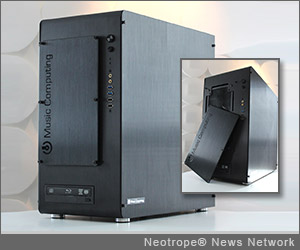 AUSTIN, Texas /eNewsChannels/ — Music Computing, Inc., the makers of advanced computer-based music production stations and leading edge touchscreen products releases CoreMC (Gen3), the world’s most powerful personal computer designed for audio and video production. Based on the Windows(R) 8 (64-bit) OS, CoreMC is capable of running any software for music production, HD video editing or even gaming.
AUSTIN, Texas /eNewsChannels/ — Music Computing, Inc., the makers of advanced computer-based music production stations and leading edge touchscreen products releases CoreMC (Gen3), the world’s most powerful personal computer designed for audio and video production. Based on the Windows(R) 8 (64-bit) OS, CoreMC is capable of running any software for music production, HD video editing or even gaming.
The concept was to use enterprise-level components found in today’s super computers, which are designed for maximum performance and stability, to create compact computer systems for personal or studio use.
CoreMC can be equipped with up to dual Xeon(R) 8-core processors (16-cores total), 768GB of RAM, 21TB of hard drive storage, the highest performance video cards and best quality audio interfaces.
It is now possible for the user to virtually run all needed applications at once, load everything into RAM and leave the system on so it can provide instant access whenever it’s needed. The very same features provided by today’s super-computing mainframe systems.
“In the past there was a need for a product class to be created for average consumers requiring professional level products, this was called ‘Prosumer,'” said Victor Wong, CEO Music Computing. “Today we face the same needs but the demand has increased to even higher levels, the new EnterprisePro personal computing systems bring the absolute highest performance and quality to the masses.”
Each CoreMC is housed in a stylish black brushed aluminum chassis equipped with four (4) oversized 140mm fans providing ample airflow, yet able to rotate at reduced speeds for near silent operation. A front name plate is part of the design and acts as a baffle to further reduce operational noise. Extras include removable dust filters to keep the interior of the system clean, shock mounting for hard drives and optical drives to reduce noise and vibration, and even anti-vibration pads for the power supply. For those needing to overclock the system, four (4) coolant hose ports are provided on the rear of the chassis with star grommets providing a professional fit.
Four (4) PCI-E 3.0 (x16) slots, One (1) PCI-E 3.0 (x8) and One (1) PCI-E 3.0 (x4) are available, which can be equipped with video cards ranging from the 1GB high-performance card included in the base model to 3-way SLI GTX 680 cards or even a Quadro 6000 card with a GPU designed specifically for Adobe software acceleration.
Audio interface options include:
Echo MIA MINI Digital Audio card (2ins balanced, 2outs balanced, MIDI, S/PDIF, 24bit-96kHz).
RME Hammerfall HDSP 9652 (3 x ADAT digital I/O, 1 x SPDIF digital I/O, S/PDIF, 1 x Word clock I/O (BNC), 1 x ADAT Sync In (9-pin D-type), 2 x MIDI I/O, 32 channels high-speed MIDI, 12 channels 96 kHz/24 bit for record and playback on ADAT optical).
RME HDSPe RayDAT (36 Inputs / 36 Outputs, 4 x ADAT I/O (up to 192 kHz via S/MUX4), 1 x AES/EBU I/O (192 kHz), 1 x SPDIF I/O (192 kHz), 2 x MIDI I/O, Supported sample frequencies: Internally 32, 44.1, 48, 64, 88.2, 96, 176.4, 192 kHz. Externally 28 kHz – 200 kHz).
The base configuration priced at $2,499 for the CoreMC is as follows: Xeon 6-core (2.0GHz) processor, 6GB RAM (3x2GB), 1TB HD, 1GB high-performance video card, DVD burner, SonicSource VSTi (3,000+ sounds / 16GB) and Windows 8 Professional (64-bit).
Rack versions of the CoreMC are available in a compact 4U (15.25-inch depth) chassis as well as a full size version with redundant power supplies.
The CoreMC is currently shipping, for complete information, please go to: http://www.musiccomputing.com/coremc .
The CoreMC video (Right Brain Version) can be seen here: http://youtu.be/BP14gcWYO9o .
The CoreMC video (Left Brain Version) can be seen here: http://youtu.be/fsCCWjJ0uFA .
For more information, and to view products available for order and shipment, visit: http://www.musiccomputing.com/ .
Copyright © 2013 Neotrope® News Network – all rights reserved.



